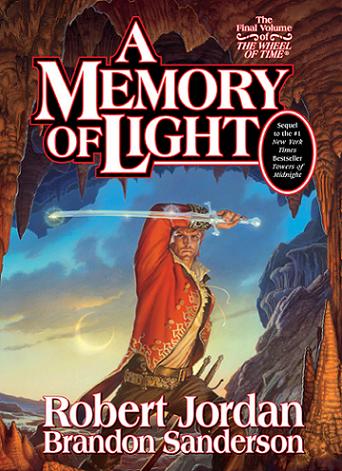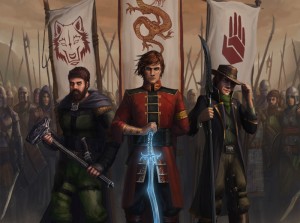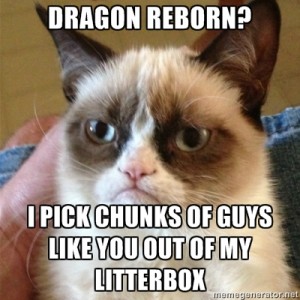Imagine, if you will, that you are cordially invited to the opening of a new theme park. Let’s say for the purposes of this metaphor that this new wonderland of amusement is called “Robert Jordan’s Fantasyland”. You arrive at this theme park eager to check out all of the new rides, having been to previous such parks as Middle-Earth, Narnia, and the World of Shannara. In this particular theme park, there are fourteen rides and one ducky pond (helpfully titled “New Spring”) for your enjoyment, but while visiting this park, you must ride the rides in a prescribed order, so as to fully maximize your experience. At the same time, some of the rides are continually under construction, so you don’t really have a choice except to follow the park’s guidelines (even though you can see some of these rides from a mile off and already know what’s up). Also, each ride has a boarding cost of $7.99, except for the mysterious ride #14, which is $34.99, but from what you can see from the street, looks incredibly awesome.
The first three rides are ultra-modern roller coasters, rides of such awesome magnitude that you are left breathless, anticipating what other joys this park has to offer. The next three are also roller coasters, though after the adrenaline rush of the first three, you are left rolling along these out-and-back rides feeling somewhat let down by the experience. “Gee,” you might say, “Those first three were awesome, but these are just long, drawn-out, old-fashioned wooden roller coasters that offer no new thrills. In fact, they hardly offer any thrills at all.” The rides are fun, but long and less involved than those first three rides. The next four are various types of carousels, flying swings, and a big, neon tower that lifts you up to about 50 feet and then drops you. These four rides are wonderfully intricate, designed with the overall aesthetic of “Robert Jordan’s Fantasyland”, yet are overly long, offer few to no exciting features, and may or may not involve a tea service. Now, you’re thinking that this park is a bit of a let-down, and while the first roller coasters were still really awesome, the rest of the rides almost feel like a waste of your time. The eleventh ride is another solid roller coaster (possibly something that dangles you from the track, which would be a nice change of pace after you paid $10 to go wade in the ducky pond to cool your feet off), but you then find that the original creator of the rides passed away before he could finish the last three. HOWEVER, a new designer has been brought into the park, and has two freakishly awesome roller coasters that whiz you along. Even though they’re fun, you can’t help but remember how amazing those first three roller coasters were, how much fun they were, and how well laid out they were in comparison with these roller coasters that feel as though they were designed by a thirteen-year-old caffeine addict.
And then you get to the 14th ride. This is no mere roller coaster you are riding; it is a ten hour long, inverted, tunneling, 120 mph metal demon that whisks you straight out of the station. It loops the loops. It goes underwater. It soars eight miles high. There’s even a section of the track where you are literally flying through the air. There are no rest stops on this roller coaster; you are at the mercy of the physics invented solely for this ride by the new designer (a Mr. Sanderson, if you will). Riding along, you can see the whole of the park, as well as brief glimpses of other far-away theme parks (because you are just that high in the air). After ten hours of pure adrenaline, you come to a gentle halt that doesn’t take too long, but still leaves you winded. And as you pull into the station, all you can do is look around and wonder “what in the hell did I just do?” while simultaneously thinking “that was awesome!” and “gee, if only I could have ridden that ride” only without the other 13 rides, this roller coaster would make even less sense than it actually does.
Welcome to Brandon Sanderson’s concluding novel of the Wheel of Time series, “A Memory of Light.”
When last we spoke here on the Recorder about Robert Jordan’s mega-universe, it was still seven months before the release of the concluding volume. In that time, it had been long enough for me to effectively file away every bit of relevant information in the WoT universe (as I’ll call it from here on out) in the deepest recesses of my mind associated with fantasy fiction. Picking up my copy, I became fearful, remembering how vast this world really is, and how many characters there are to remember. One of the major joys/flaws of the WoT is how broad of a canvas Jordan and Sanderson are working on, and how the literally hundreds of characters can, at times, melt together into one globular, unrecognizable whole. When I started reading, I became fearful that I wouldn’t remember who these people are, beyond the main players, and that there would be lengthy chunks of pages where I would spend more time and energy trying to remember who the sub-commander of the Illian army is rather than paying attention to what is going on. Fortunately, Sanderson recognized that problem and made sure that the story is easy to follow.
How did he do this, you might ask?
By slamming the pedal to the medal, pointing the car straight down the road, and never letting off the gas.
“Memory of Light” deals with the events of Tarmon Gai’don, the Last Battle and the whole point of the series that we’ve been driving towards for 22 years. By reading this, Sanderson knows that there’s a lot of loose ends and plot points that need wrapping up, and he does this by literally giving 909 pages over to dealing with the events of the battle itself. “Memory of Light” is a giant war book with constant battle scenes, deaths around every corner, and more Trolloc blood than you ever thought you would need in your life. It’s an exhilarating read from start to finish, and at no point is there ever really a break in the action; there is always something going on, which is a relief, considering how dull some of those books in the middle are.
The book begins with a lengthy prologue that picks right up where “Towers of Midnight” left off, plunging several minor characters into the first skirmish/battle of the Last Battle. Sanderson reintroduces several minor characters, allowing you to live and die with them. He chooses to focus on several individuals this time around, rather than the full spectrum of WoT characters. Entire passages are spent with characters who were not even introduced until Book Nine of the series, and by continually pressing the danger and raising the stakes, a reader should be able to find themselves far more invested in the action. It’s much easier to care about a character when their life is at stake, instead of their tea possibly growing cold and being served in the improper fashion.
Rand al’Thor, the whiny main character, is fully committed to his actions in this tome; however, Sanderson has allowed him to grow and become a layered human being this time around. It is constantly referenced about how he has finally “become a man(adult)” by this point, ready to take on the weight of becoming the Dragon Reborn. Yes, he is still in love with three women. Yes, nobody really bats an eyelash at this. There’s simply too much going on for anyone to really care about this, especially once the various heroes disappear to all corners of the world to fight the battle.
The structure is easy enough to follow; there are four initial battle fronts for the book, which eventually reduce down to two; Rand’s battle with Shai’tan and the rest of the heroes struggling for their lives against the hordes of darkness. To Sanderson’s credit, even though it is entirely possible to see far in advance how this story will wrap up, he continually raises the stakes and perils so that the reader is left guessing about whether or not certain characters will actually survive. Some of the characters are given magnificent death scenes; some are killed off-screen(page), and some are quite suddenly obliterated without a second thought. By the end of the book, everything has been resolved, and again to Sanderson’s credit, he doesn’t spend a great deal of time in the wrapping up of events; characters are given their final scenes before moving on in an effective 20 page epilogue that leaves the palate satisfied.
Now, let’s delve a little bit deeper into the book.
For starters, even though the book is 900 pages long, certain characters are given short shrift. This is obviously going to happen in a world of this magnitude, but some of the characters receiving less screen time are people who have been major players since the first book. Nynaeve, the pouty Aes Sedai who joined the adventure in “Eye of the World”, is essentially given seven pages of her own time, as she literally spends most of the book standing and watching Rand. The same for Moiraine, revived in the last book only to be stuck in a cave watching shit happen. Thom, the traveling gleeman, sits outside a cave, and is given two-and-a-half pages of his own perspective. Meanwhile, the second-in-command of Mat’s Band of the Red Hand receives at least 75 pages of his own, chronicling his adventures in the battle. To be fair, the characters lacking in play time are more the victims of what happens in the confrontation with Shai’tan, and how Sanderson/Jordan have chosen to script that particular encounter.
This winds up being my main problem with the book. For the past 13 books and 10,000 plus pages, the whole focus has been on Rand’s coming battle with the Shadow. One would think that this would be a mammoth battle, with fire, explosions, and a titanic duel between Rand and the forces of darkness. Instead, we are presented with Rand fighting one of the horrible Forsaken, stepping into a giant pool of blackness, and falling into a mental confrontation for four hundred pages while the aforementioned Aes Sedai are stuck watching their Dragon Reborn frozen in the middle of a fight.
(Let’s talk quickly about Shai’tan, while we’re at it. I realize that he’s the disembodied Shadow, the Lord of Darkness, and can’t really have a physical role to play. With that being said, every time he chooses to voice something, SANDERSON MAKES HIM SPEAK IN ALL-CAPS. WHILE EFFECTIVE FOR COMMUNICATING THAT THIS IS A DISEMBODIED PRESENCE RATHER THAN A VOICE, IT HAS THE UNFORTUNATE SIDE-EFFECT OF MAKING THE ULTIMATE VILLIAN OF THE UNIVERSE SOUND LIKE AN INTERNET CAT MEME.)
The rest of the villains are actually given more to work with in this book than in previous editions of the series. We are given a great deal of face-time with the remaining members of the Forsaken, something that was notably lacking as Rand routinely popped them off like he was playing “Duck Hunt” in his father’s basement. In particular, Lanfear and Moridin are given great moments, while Demandred and Graendal, two Forsaken we haven’t seen, get to be dastardly villains far more often. This helps readers to know exactly why the Forsaken are to be feared as such, and makes for all the more satisfactory conclusions when they finally get to meet their makers. (Moghedian’s fate in particular is comically appropriate, while still maintaining an appropriate air of gravity.)
The one big problem that I encountered with the book was not during the reading, although Sanderson’s breath neck pace could stand for a few more rest stops here and there, but reaching the conclusion. After finishing the ultimate tome of the Wheel of Time, I couldn’t help but reflect back on the rest of the series, thinking about how Sanderson’s prose matches up with Jordan’s (they don’t; you immediately know you’re reading the work of a different author, although that can’t be helped), and about how much prior time I had invested in this series. The fourteen books together are necessary for one to have a single clue about what’s happening in this universe, and the pay-off of reaching Tarmon Gai’don is decidedly enjoyable; what feels wrong is that I still feel a bit cheated for having been made to read the middle chunks where the plot remains locked in stasis while other events keep happening outside in the world. The overwhelming action in “Memory of Light” does not make up for a lack of action in, say, “Winter’s Heart”. I can only think back to the amount of time invested in this world, and realize that while “Memory of Light” was fun, I had to waste my time with the other books to get there. I realize this is a petty gripe, and that I personally chose to read these books, but I can’t help but feel that if I wanted to go back and read WoT again, it would be a month’s long project just to reach “Memory of Light”.
And who really has the time for that?
ULTIIMATE REVIEW: B+; solid action, breathtaking pace, mostly effective use of time and characters, satisfying resolutions; however, you still have to read the first thirteen.








